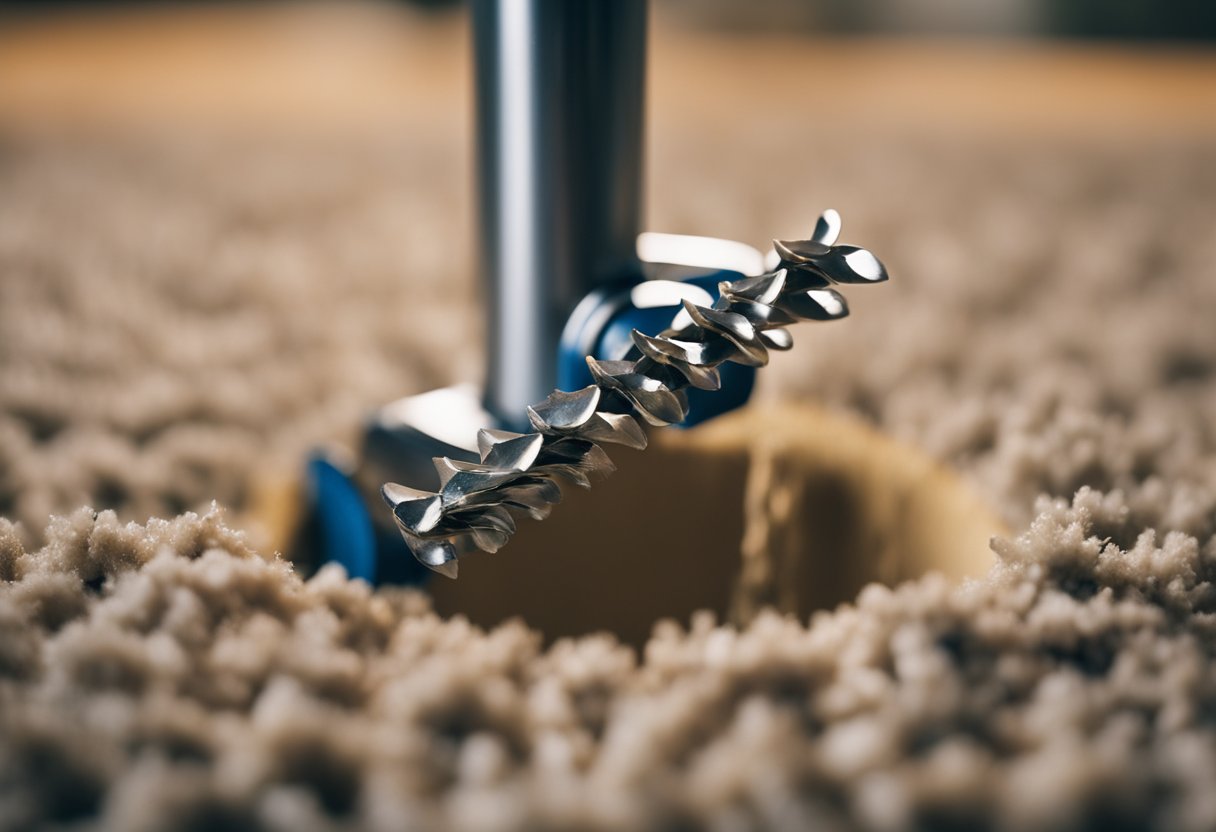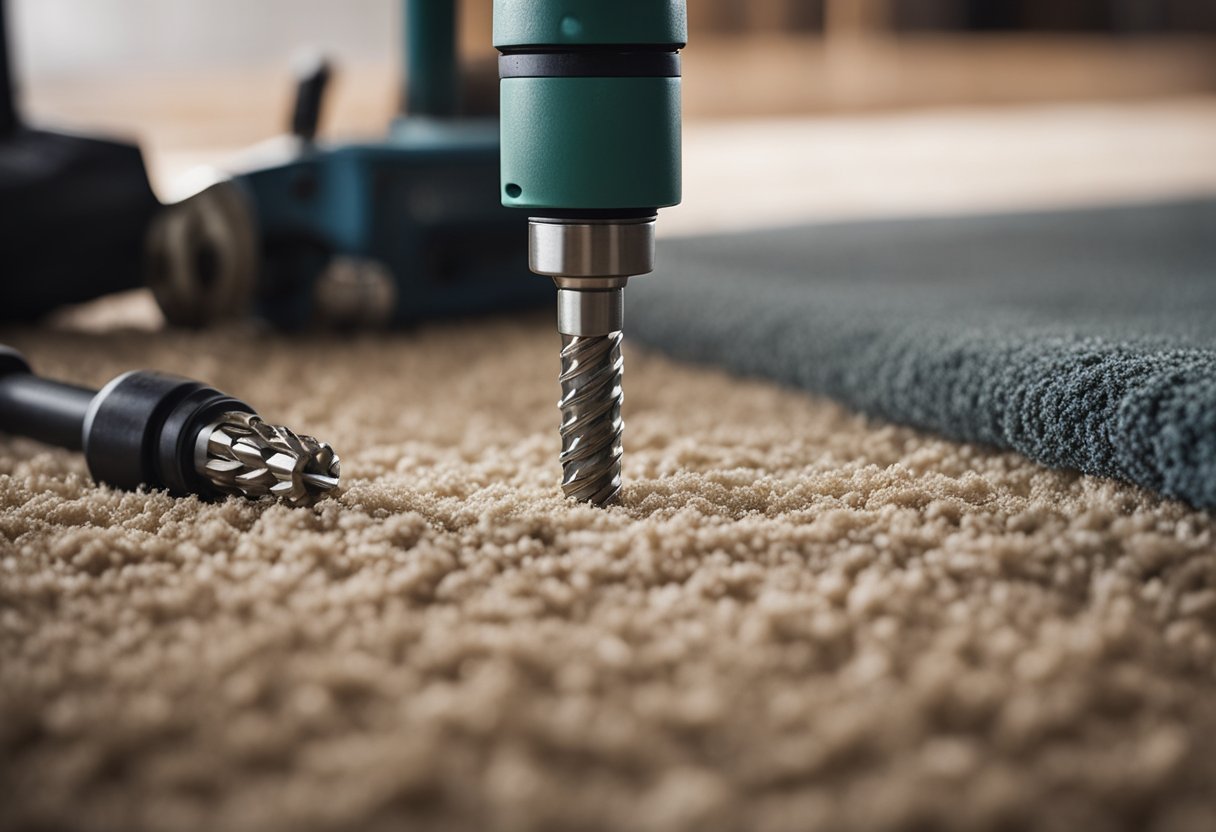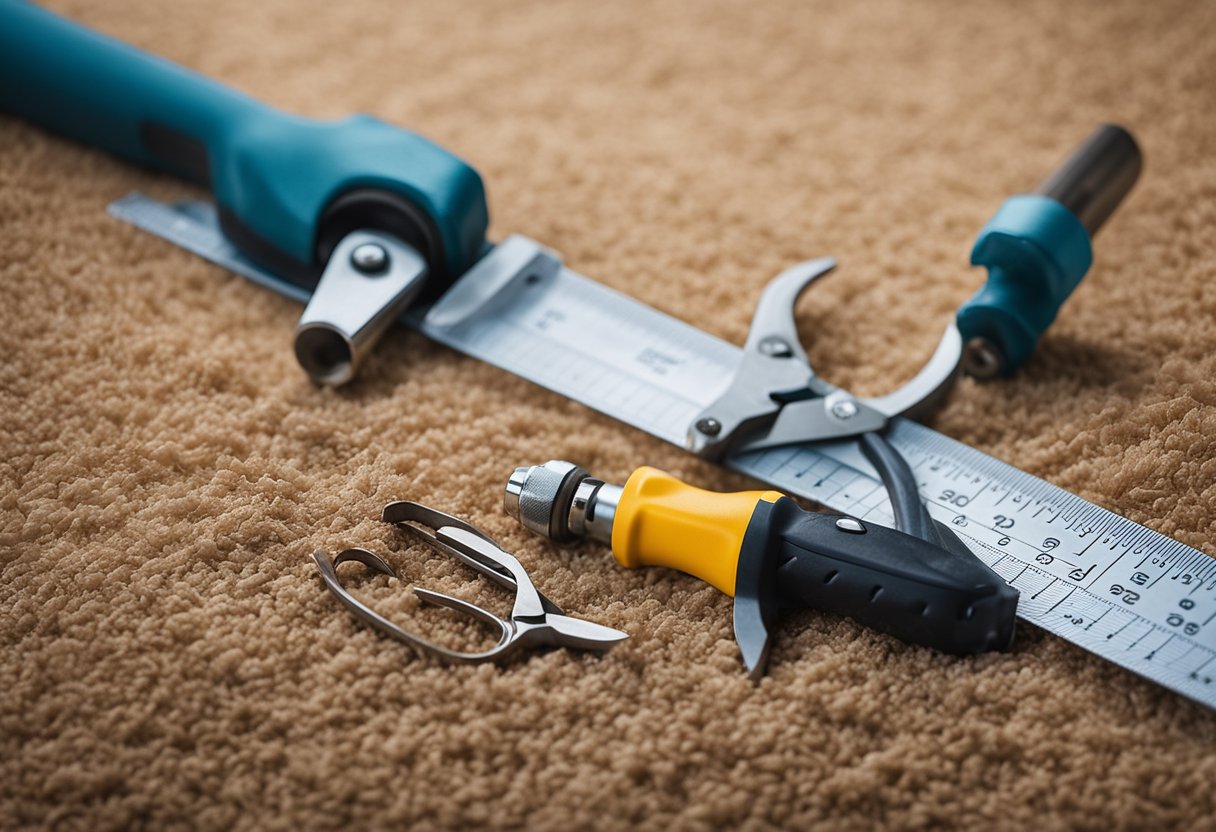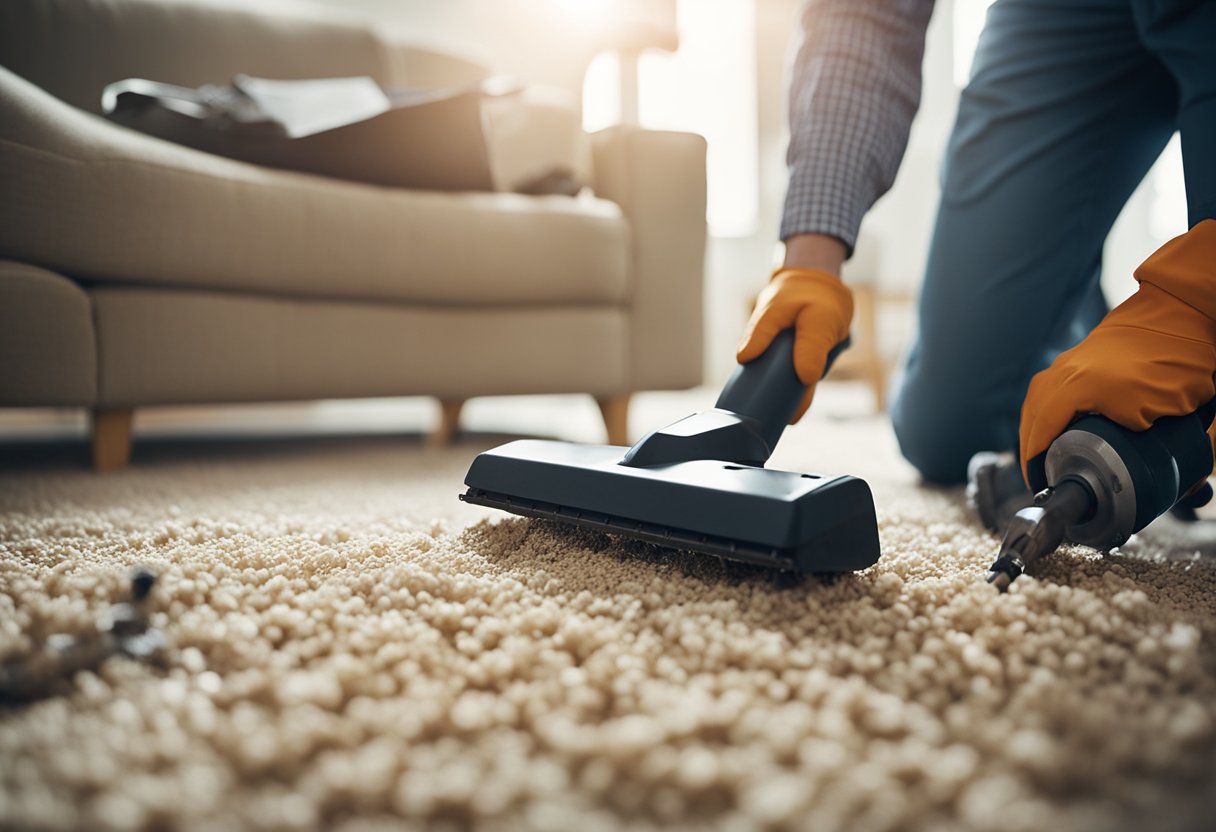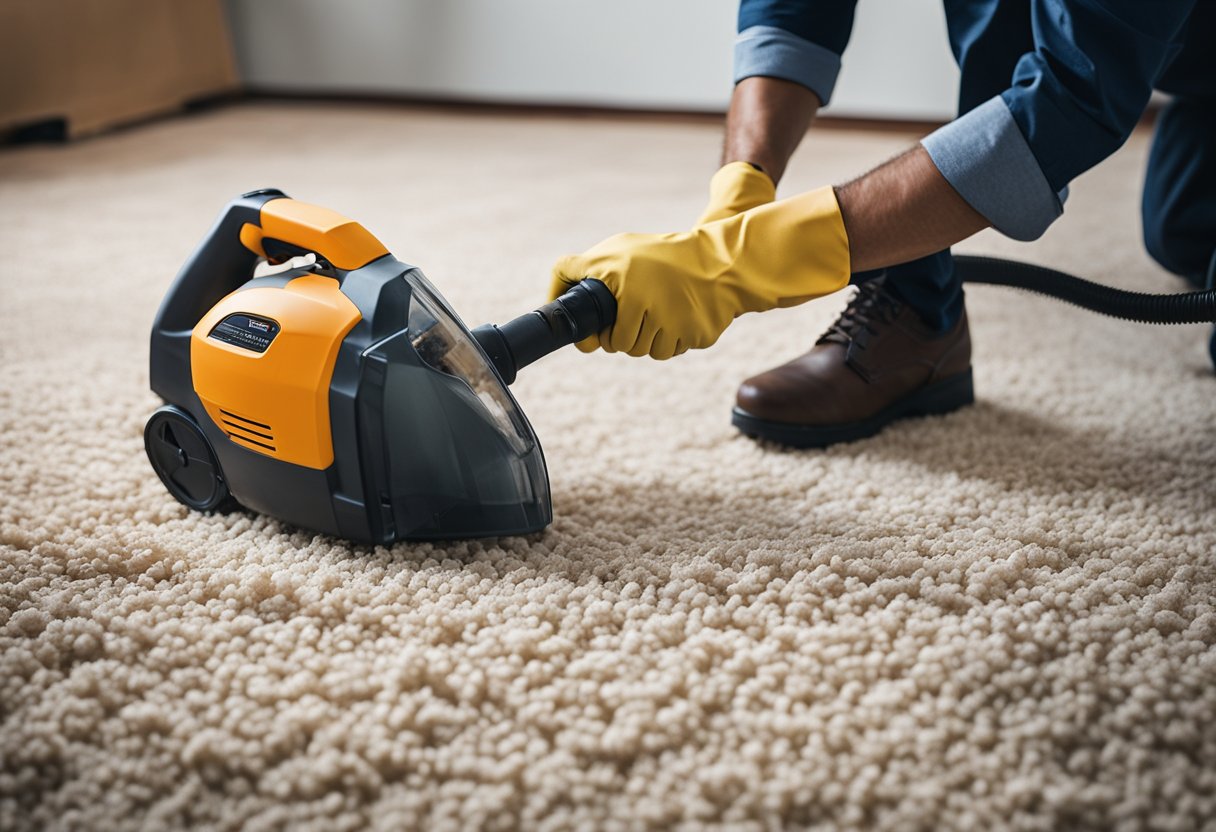Drilling through carpets can be a challenging task, especially if you want to avoid damaging the carpet fibers. Whether you want to install new baseboards, hang a picture frame, or run a cable, drilling through carpet requires a bit of skill and patience. In this article, I will share my tips and tricks on how to drill through carpet without damaging it.
Before we get started, it’s important to understand the different types of carpets and how they can affect the drilling process. Carpets can be made of various materials, including nylon, wool, polyester, or olefin. Some carpets have a low pile, while others have a high pile. The type of carpet you have can affect the amount of pressure you need to apply while drilling and the type of drill bit you should use. Now that we have a basic understanding of carpets, let’s dive into the details of how to drill through them.
Key Takeaways
- Understand the type of carpet you have before drilling to select the right drill bit and apply the appropriate amount of pressure.
- Use a punch or masking tape to prevent snagging while drilling through carpet.
- Clean up any debris and maintain your tools to ensure they last longer.
Understanding Carpets and Their Types
https://www.youtube.com/watch?v=q09P8S_GOp8&embed=true
As a homeowner, you may encounter a variety of carpet types when drilling through your floors. It’s important to understand the different types of carpets and their structure to avoid damaging them during the drilling process.
Recognizing Different Types of Carpet
Carpets can be classified into two main types: loop pile and cut pile. Loop pile carpets, also known as uncut pile or Berber pile, leave the yarn loop intact, while cut pile carpets cut the loops to create individual strands.
Loop pile carpets are more durable and resistant to wear and tear, making them ideal for high-traffic areas. On the other hand, cut pile carpets are softer and more comfortable to walk on, making them perfect for bedrooms and living rooms.
Understanding Carpet Backing and Padding
Carpet backing is the material that holds the fibers together and provides structure to the carpet. It can be made of various materials, including jute, polypropylene, or polyester. The backing also determines the carpet’s stability and durability.
Carpet padding, also known as underlay, is the layer of material placed underneath the carpet. It provides cushioning and insulation, reduces noise, and helps to extend the life of the carpet. Not all carpets come with padding, so it’s important to check before drilling to avoid damaging the subfloor.
When drilling through carpet, it’s important to take into account the type of carpet, backing, and padding underneath. By understanding the structure of your carpet, you can make informed decisions when drilling and avoid damaging the fibers or subfloor.
Required Tools and Their Selection
When it comes to drilling through carpet, there are a few tools that you will need to have on hand. In this section, I will discuss the tools that are required for this task and how to select the right ones.
Choosing the Right Drill Bit
The drill bit is one of the most important tools you will need when drilling through carpet. It is essential to choose the right drill bit for the job to ensure that you get the best results. A drill bit that is too large will create a hole that is too big, and a drill bit that is too small will not be able to create a hole that is large enough for the screw.
When choosing a drill bit for drilling through carpet, you should choose one that is slightly smaller than the diameter of the screw you will be using. This will ensure that the screw fits securely and tightly in the hole without damaging the carpet fibers. A small or medium tip drill bit that won’t snag the carpet is ideal. A sharp, carbide-tipped drill bit is also suitable for drilling through carpeting. Avoid using dull or damaged drill bits, as they are more likely to snag the fabric.
Other Necessary Tools
Aside from the drill bit, there are a few other tools that you will need to have on hand when drilling through carpet. These include:
-
Cordless or standard drill: A drill is necessary to make the hole in the carpet. A cordless drill is ideal because it allows you to move around freely without being tethered to a power outlet.
-
Utility knife or sharp knife: You will need a utility knife or a sharp knife to cut the carpet. This will allow you to create a hole that is the right size for the drill bit.
-
Pencil or chalk: You will need a pencil or chalk to mark the spot where you want to drill the hole. This will help you to make sure that the hole is in the right place.
-
Vacuum cleaner: A vacuum cleaner is necessary to clean up any debris that is left behind after drilling through the carpet. This will help to prevent any damage to the carpet fibers.
-
Rotary tool: A rotary tool can be used to create a hole in the carpet. This is a good option if you do not have a drill.
In conclusion, when it comes to drilling through carpet, it is essential to have the right tools on hand. Choosing the right drill bit and having the other necessary tools will ensure that you get the best results.
Preparation Before Drilling
Before drilling through carpet, proper preparation is essential to avoid damaging the carpet fibers. Here are the key steps to take before drilling:
Marking the Spot
First, mark the location of the hole with a marking pen or chalk. You can also use a piece of masking tape to mark the spot. Make sure the spot is in an area where the carpet is not loose or wrinkled. If the carpet is loose or wrinkled, it can get caught in the drill bit and cause damage.
Protecting the Carpet
To protect the carpet when drilling, place a piece of cardboard, scrap wood, or plywood under the spot where you will be drilling. This will provide a solid surface for the drill bit to go through and prevent it from catching on the carpet fibers.
If you need to make a larger hole, use a carpet cutter to cut through the carpet fibers before drilling. This will make it easier to drill through the carpet without damaging it.
By taking these steps to prepare the carpet before drilling, you can avoid damaging the carpet fibers and ensure a clean, precise hole.
Drilling Techniques and Tips
https://www.youtube.com/watch?v=d6qzo3LYTR4&embed=true
When drilling through carpet, it is important to use the right technique to avoid snagging or damaging the carpet fibers. Here are some tips to help you drill through carpet like a pro.
Drilling Without Snagging
To drill through carpet without snagging, wrap a masking tape around the drill bit’s thread. This way, it does not get the carpet’s threads when it goes down into the carpet while drilling. Another way to avoid snagging is to use a punch slightly larger than the required hole to avoid any snagging while drilling through carpet.
Maintaining the Right Speed and Pressure
When drilling through carpet, it is important to maintain a low speed setting and use light pressure. This will help prevent the drill bit from catching on the carpet fibers and causing damage. It is also important to keep the drill bit perpendicular to the carpet surface to prevent it from wandering.
Creating a Guide Hole
Creating a guide hole or pilot hole can help prevent the drill bit from wandering or catching on the carpet fibers. To create a guide hole, use a smaller drill bit to create a shallow hole in the carpet. This will help guide the larger drill bit and prevent it from catching on the carpet fibers.
By following these techniques and tips, you can drill through carpet without snagging or damaging the carpet fibers. Remember to always use a low speed setting, light pressure, and create a guide hole to ensure a successful and damage-free drilling experience.
Dealing with Different Surfaces
https://www.youtube.com/watch?v=9DQQwMlNlC4&embed=true
When drilling through carpet, it is important to know what type of surface lies beneath it. Different surfaces require different techniques and tools to drill through. Here are some tips for drilling through common surfaces:
Drilling Into Subfloors
Subfloors are typically made of plywood or oriented strand board (OSB), and are the surface beneath the carpet. When drilling through a subfloor, use a standard drill bit that is slightly smaller than the diameter of the screw you will be using. You can also use a masonry bit if the subfloor is made of concrete. Be sure to drill straight down into the subfloor to avoid damaging any pipes or wires that may be beneath it.
Drilling Into Joists
Joists are the horizontal beams that support the subfloor. When drilling through a joist, it is important to use a wood drill bit that is slightly smaller than the diameter of the screw you will be using. Be sure to drill straight through the center of the joist to avoid splitting it. If you are unsure where the joists are located, use a stud finder to locate them.
When drilling through either a subfloor or joist, it is important to take into account the thickness of any underlayment that may be present. Underlayment is a thin layer of material that is installed on top of the subfloor to provide a smooth surface for the carpet. If there is underlayment present, be sure to adjust the length of the drill bit accordingly.
In summary, drilling through carpet requires different techniques and tools depending on the surface beneath it. When drilling through a subfloor, use a standard drill bit or masonry bit, and drill straight down. When drilling through a joist, use a wood drill bit and drill straight through the center. Be sure to take into account the thickness of any underlayment that may be present.
Post-Drilling Cleanup and Maintenance
After drilling through the carpet, it is essential to clean up the debris to avoid any accidents or injuries. Here are some tips to help you with the post-drilling cleanup:
Removing Debris
To remove the debris left behind after drilling through the carpet, you can use a vacuum cleaner. Ensure that the vacuum has enough suction power to pick up all the debris. You can also use a dustpan and brush to sweep up the debris. It is essential to remove all the debris to prevent it from getting stuck in the carpet fibers.
Taking Care of the Carpet
After drilling through the carpet, you may notice some fraying or snagging around the drilled hole. To prevent further fraying, you can apply some adhesive around the edges of the hole. This will help to keep the carpet fibers in place and prevent them from getting snagged.
It is also essential to clean up any adhesive residue left behind after drilling through the carpet. You can use a cloth soaked in warm water to wipe away any adhesive residue. Avoid using any harsh chemicals or solvents as they may damage the carpet fibers.
In conclusion, drilling through carpet requires some care and caution. However, with the right tools and techniques, it can be done without causing any damage to the carpet. After drilling through the carpet, it is essential to clean up the debris and take care of the carpet to prevent any further damage.
Safety Measures and Precautions
As with any home renovation or DIY project, safety should always be a top priority when drilling through carpet. Here are some safety measures and precautions to keep in mind:
1. Turn off electrical wiring
Before starting, make sure to turn off any electrical wiring in the area where you will be drilling. This will help prevent any accidents or electrocutions. If you are unsure about the electrical wiring, it is best to consult a professional electrician.
2. Use an extension cord
When drilling through carpet, it is important to use an extension cord that is long enough to reach the area where you will be working. This will prevent you from accidentally tripping over the cord and injuring yourself.
3. Wear protective gear
Always wear protective gear, such as safety glasses and gloves, when drilling through carpet. This will help protect your eyes and hands from any debris or sharp edges.
4. Use the right drill bit
Choosing the right drill bit is crucial when drilling through carpet. Make sure to select a drill bit with a small or medium tip that won’t snag the carpet. This will help prevent any damage to the carpet fibers.
5. Secure the drill bit
To prevent the drill bit from slipping, use masking tape to secure it in place. This will help ensure that the hole is drilled in the right location and at the right angle.
By following these safety measures and precautions, you can ensure that your DIY project goes smoothly and without any accidents. Remember to always take your time and be careful when drilling through carpet.
Frequently Asked Questions
https://www.youtube.com/watch?v=LH5Ftw71x5E&embed=true
What type of drill bit should I use to drill through carpet?
When drilling through carpet, it’s best to use a small or medium-sized drill bit with a sharp tip. A dull or worn-out drill bit can snag the carpet fibers, causing damage to the carpet. A diamond-tipped drill bit is also a good option for drilling through carpet, as it can easily cut through the fibers without causing any damage.
What is the best way to avoid damaging the carpet while drilling?
To avoid damaging the carpet while drilling, it’s important to secure the carpet fibers in place. This can be done by using masking tape to cover the area where you plan to drill. The tape will help keep the fibers in place and prevent them from getting caught in the drill bit. It’s also a good idea to start drilling at a slow speed to prevent the drill bit from catching on the fibers.
How can I make sure the hole is in the right spot before drilling?
Before drilling through carpet, it’s important to make sure that the hole is in the right spot. One way to do this is to use a marker or pencil to mark the spot where you want to drill. You can also use a template or guide to help you drill the hole in the right spot. Another option is to use a stud finder to locate any underlying studs or joists that may be in the way.
Are there any special precautions I should take when drilling through boat carpet?
When drilling through boat carpet, it’s important to take extra precautions to avoid damaging the carpet. Boat carpets are often made from more delicate materials than regular carpets, and they may be more prone to damage. To avoid damaging the carpet, it’s best to use a small drill bit and start drilling at a slow speed. It’s also a good idea to use a guide or template to help you drill the hole in the right spot.
What tools do I need to drill through carpet?
To drill through carpet, you’ll need a drill, a drill bit, masking tape, and a carpet patch. You may also want to use a template or guide to help you drill the hole in the right spot. If you’re drilling through boat carpet, you may need to use a smaller drill bit and take extra precautions to avoid damaging the carpet.
Can I use a hole saw to drill through carpet?
While it is possible to use a hole saw to drill through carpet, it’s not recommended. Hole saws are designed to cut through wood and other hard materials, and they may cause damage to the carpet fibers. It’s best to use a small drill bit and start drilling at a slow speed to avoid damaging the carpet.

Hi, I’m Sal Muller of Tooltrip.com. My DIY experience led me to understand essential power tools for home projects. Tooltrip.com guides enthusiasts and professionals in choosing right tools for any job. I provide concise top tool reviews for easier, efficient DIY.

